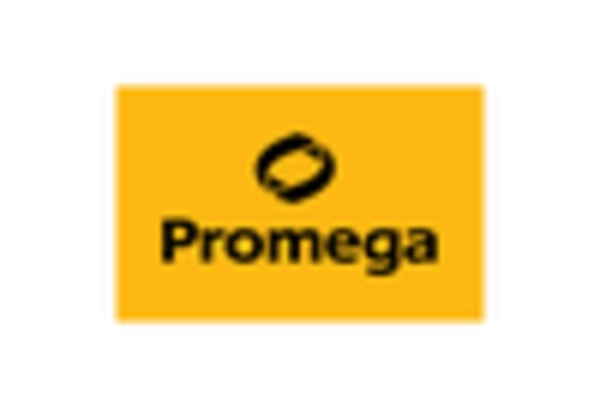Emergence of Personalized Medicine
The shift towards personalized medicine is significantly influencing the Transfection Reagents And Equipment Market. As healthcare moves towards tailored treatments based on individual genetic profiles, the demand for transfection technologies that facilitate gene editing and modification is increasing. Personalized medicine relies heavily on the ability to manipulate genetic material, making transfection reagents essential tools in this paradigm shift. Market forecasts indicate that the personalized medicine sector is likely to grow at a rapid pace, with transfection technologies playing a pivotal role in the development of customized therapies. This evolution in healthcare is expected to drive sustained growth in the transfection market.
Growing Investment in Biotechnology
Investment in biotechnology is a key driver for the Transfection Reagents And Equipment Market. As biopharmaceutical companies and research institutions allocate more resources towards genetic research and development, the demand for transfection reagents is likely to increase. Reports indicate that the biotechnology sector is expected to reach a valuation of several hundred billion dollars, with a substantial portion dedicated to genetic engineering and molecular biology. This influx of capital is fostering innovation in transfection technologies, thereby enhancing the capabilities of researchers and clinicians. Consequently, the market for transfection reagents and equipment is poised for significant expansion as these investments translate into new product developments and applications.
Rising Applications in Therapeutics
The Transfection Reagents And Equipment Market is witnessing a rise in applications within therapeutic areas, particularly in gene therapy and cancer treatment. The increasing prevalence of genetic disorders and cancers is driving the need for effective therapeutic solutions that utilize transfection technologies. For instance, the use of CRISPR-Cas9 systems for gene editing in clinical trials is becoming more common, necessitating reliable transfection methods. Market analysis suggests that the therapeutic segment of the transfection market could account for a substantial share, potentially exceeding 40% by the end of the decade. This trend underscores the critical role of transfection reagents in developing next-generation therapies.
Advancements in Gene Delivery Systems
The Transfection Reagents And Equipment Market is experiencing a notable surge due to advancements in gene delivery systems. Innovations such as lipid nanoparticles and viral vectors are enhancing the efficiency and specificity of transfection processes. These developments are crucial for applications in gene therapy and vaccine development, where precise delivery of genetic material is paramount. The market for transfection reagents is projected to grow significantly, with estimates suggesting a compound annual growth rate of over 10% in the coming years. This growth is driven by the increasing need for effective gene delivery methods in both research and therapeutic settings, indicating a robust demand for advanced transfection technologies.
Increased Research and Development Activities
The Transfection Reagents And Equipment Market is benefiting from increased research and development activities across various scientific fields. Academic institutions and private research organizations are intensifying their focus on molecular biology, genetics, and related disciplines, leading to a higher demand for transfection reagents. Data suggests that R&D spending in life sciences is on the rise, with many institutions prioritizing genetic research. This trend is likely to result in a greater need for innovative transfection solutions, as researchers seek to explore new avenues in gene function and regulation. Consequently, the market for transfection reagents and equipment is expected to expand in response to these heightened research efforts.

















Leave a Comment